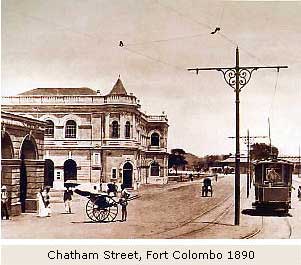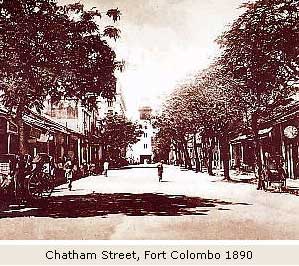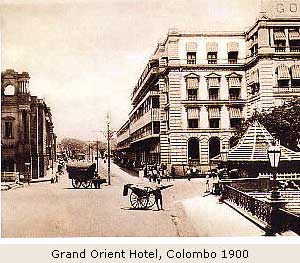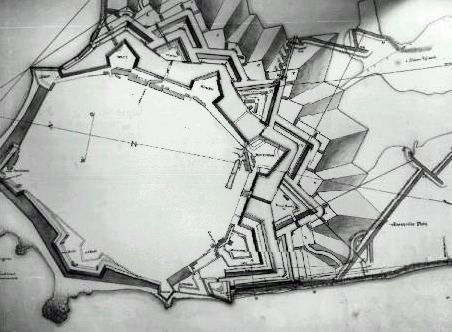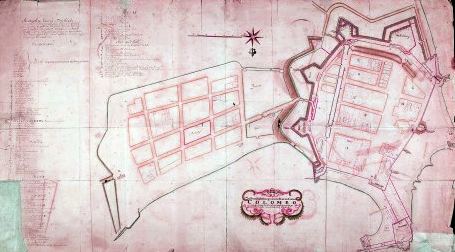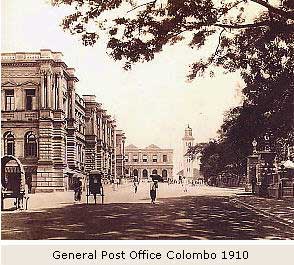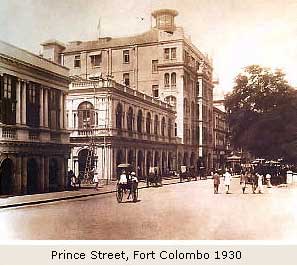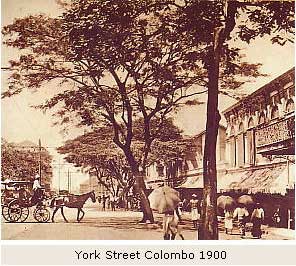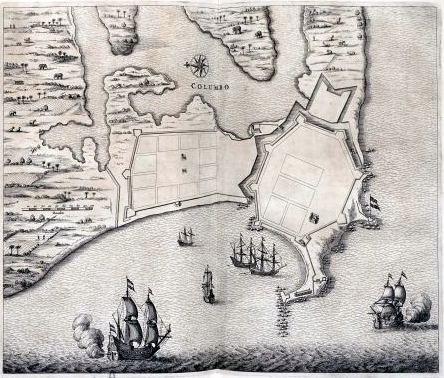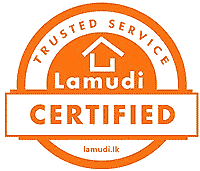
|
|||||||||
|
| |||||||||
Colombo of Those Days
Sometime, in the latter part of the 1800's, Colombo was a green city. Life, then, was simple and leisurely, calm and quiet and peaceful in many ways. There were one horse carriages and rickshaws, drawn by scrawny brown men, plying along the Galle Road in the midst of the Fort that skirted the harbor which opened out to the Indian Ocean on the west. The name is supposed to be derived from the Sinhalese kola & amba meaning 'leafy mango tree', a tree with leave only and no fruit. Thus giving kolamba which has evolved into Colombo. Another conjecture is that the name may have been derived from the fact that the Moor traders used to bring their boats in down the Kelani river through the Kelanitota (Kelani Port), which evolved into Kolontota and thereafter Kalambo. The Portuguese contribution is that the name has links to Columbus. Streets and edifices have been a significant feature of Colombo from its very early days. One of the most striking buildings, even visible from the sea as reported by the Portuguese was the Colombo Grand Mosque, supposed to have been built by the Arab traders in 1505, located at New Moor Street. All old maps from the Portuguese era show this Mosque very significantly. Chatham Street, intersected by Queens Street on the west and York Street further east were the main streets that housed both businesses and homes. Prince Street, parallel to Chatham Street ran straight down joining up with Main Street which flowed into the Pettah. The Grand Oriental Hotel, commonly referred to as the GOH, stood magnificent and tall by the port. Today it has been converted to the Hotel Taprobane with all its fineries and modern trappings. Bristol Street stood on York Street with its polished wooden stairway. The Globe Hotel and British India were noted for their watering services to the thirsty and weary. Trees lined all the streets in beautiful cascades of brown and green enveloping the area in splendor. York Street bordered the eastern wall and moat of the old Dutch Fort. This stretch gave way to the Registrar General's office, the Bristol Hotel, the National Bank of India, and Victoria Arcade. Later, they too gave way to the more modern structures of concrete that have surfaced today. Baillie Street, now Mudalige Mawatha, was wedged in between Chatham Street and Prince Street, parallel to both, and serviced the tourists with their needs of trinkets, souvenir's, tea, jewellery and gems. Queen's House, now referred to as President's House, stood on Queen Street, bringing back memories of so many memorable days of Portuguese, Dutch and British political rule, power and fisticuffs. The lighthouse clock tower stood gallantly at the intersection of Chatham Street and Queen Street where it still stands tall to this day in 2005. It was first built in 1857 and its conception and planning was carried out as far back as 1815. Royal College stood in its old green location past the Fort Railway Station by the lush green plains of that area called Captains Gardens. The Galle Face Green stretched out from the Fort towards the Galle Face Hotel that clung to the western coastline where the land extended towards the south of the island. The Beira Lake boasted of an opulence of inland water that stood right in the center of the city of Colombo running its rivulets to various parts of the city in streams and canals. The lake was named "Beira" to commemorate the name of the Dutch Engineer Johann de Beira in AD 1700, who constructed the mouth and water defences of the Dutch Fort. The lake, a long established part of Colombo, was originally an extensive "reach of flood water" from the Kelani River. It was originally called Lagoon by the Portuguese and was filled with alligators and crocodiles, thus giving the name Kayman's Gate for a nearby street. The military barracks, referred to as Echelon Square now, stood towards the Galle Face. St. Josephs College, the premier Roman Catholic educational institution in the city, lay more eastwards from the lake, amidst tall palms and beautiful flowering trees. The Victoria Park, referred to now as the Vihara Maha Devi Park, stood sprawling in its lush green and vegetaion in Cinnamon Gardens. The main towns of Colombo where people mingled and action permeated daily life were, the Fort, Pettah, Hultsdorf, and Mutuwal in the north. It was on the 3rd of Sep 1802 that the last Dutch Governor of Colombo, van Angelbeck, killed himself for having capitulated to the British. He was buried next to his wife, Vrouw Angelbeck's coffin in the crumbling Chapel that was used to bury eminent Dutch persons. Others who were buried there were Hertenberg, Vreeland, Van Eck, & Falk. Angelbecks niece, Jacomina Gertrude, daughter of Van der Graaf and wife of Hon George Melville Leslie (an English Civil Servant), was his only heir. She inherited the massive mansion, Queens House (named after Queen Victoria's ascension to the throne) then and is called President House now, and the largest and most opulent in the Fort at that time. However, she was compelled to sell the house to the Government for 35,000 Rix Dollars on account of monies owed to the state by her husband who was the Paymaster General and was subject to the shortage of a sum of over 10,000 Pounds to his utter embarrassment. The deed of transfer was confirmed and completed on January 17 1804. The street on which it is located was originally referred to as KingsStreet, then changed to Queen Street and now has now been renamed to Presidents (Janadhipathi Mawatha) Avenue. The British Raj, who took over colonial power from the Dutch in 1796, appointed John MacDowall of the Madras Service as the administrator of the city of Colombo. He was also the Collector. At that time it was estimated that the city had around 50,000 inhabitants. The Dutch and Portuguese continued to live in their occupied residences in the Pettah while the Sinhalese, Tamils and Moors preferred to live in the suburbs. The Brits too preferred the Fort and divided it into quarters based on its principal roads. It was towards the end of 1798 that Frederik North arrived and was appointed the fist Civil Governor of Ceylon by the Brits. He brought a handpicked band of civil servants along with him to run the islands administrative affairs. Among them were Eudelin de Jonville and Antony Bertolacci, a Frenchman. One of the most noted of North's many duties was 'Christianization', and towards that end an academy was established where the sons of rich Sinhalese, Indians and Europeans studied together. By 1801 there were 170 parish schools in the island and 342,000 native Protestants in addition to greater number of Roman Catholics, a legacy of the Portuguese era of colonialism. Governor North was succeeded by Sir Thomas Maitland. He preferred to live by the sea at Mount Lavinia, a few kilometers south of the city of Colombo. He was responsible for moving the tombs of the Dutch interred at the Chapel in the Fort to be re-buried at the premises of the Wolfendhaal Church in the Pettah. However, when the coffins were finally moved, under a very impressive military guard and parade of fife and drums, it was General Sir Robert Brownrigg Bart, who was Governor. He was flanked by the Chief Justice, Hon Sir Alexander Johnston and the Puisne Justice, the Hon Mr William Coke. Colombo even had its first circulating library in 1801, run by Michael Loghlin, a merchant who had sailed in from Madras. He also ran an auction house. Many other European houses and businesses soon sprang up in the Fort. Many of those who managed these businesses were retired sea captains who found that this was a lucrative opportunity to further their careers. Amongst them were L.D. Bussch, George Steuart, George Boyd, James Steuart, F. B. Montcur, John Pierre Jummeaux, W. C. Gibson and George Winter. There was also an English watchmaker. The Sinhalese referred to the Pettah as Pita Kotuwa meaning "outside the Fort" which was what it really was and is to this day. The Pettah still houses the many wholesale and retail businesses and vendors as it used to before. Although most of the business in Colombo has now been decentralized to the many smaller towns within the Pettah still stands tall as the hub of key business activity. The Central Bus Station is located in the Pettah and the Fort Railway Station also lies within its perimeter. It is from these two hallowed echelons of public transportation that the thousands of daily workers, tradesmen and ordinary people commute to and from the city. Many famous men of that era used to live in the Pettah. One was Sir Richard Morgan, Queens Advocate, who was born in Prince Street in 1821. Gradually the resident population moved to other localities like Hultsdorp, San Sebastian, Messenger Street, and Dias Place. The Mudaliyars lived around the Wolfendaal and many of them were housed on Silversmith Street. Udugaha Mudaliya, grandfather of SWRD Bandaranaike, Sir Thomas de Sampayo, and a member of the Legislative Council, James D'Alwis who was also a well known oriental scholar lived down this street. The Nattukottai Chettiars, who were descendants of those who had migrated from South India, were mostly involved as money changers, pawn brokers, and Jewellery manufacturers, distributors and retailers. They lived and conducted their businesses in and around New Chetty Street, which was named after them, and further at Grandpass. Queen's Advocate Selby lived in a mansion called Selby House which latyer went on to become the premises of M/S Heptulabhoy & Co, a flourishing export oriented business run by a Borah merchant who renamd it to Selby Stores. Mutuwal too became a very fashionable suburb for residency. The Brit Collector of Customs had his home there adjoining the salt lake. The Auditor General, H A Marshall built three large residences, Rock House, Whist Bungalow and Modera House. Rock House was occupied by Sir William Coke, the Chief Justice. The Armitages occupied Modera House and Whist Bungalow was the residence of an English gentleman. Later, Sir Richard Morgan purchased Whist Bungalow on which he spent large sums of money re-decorating and refurbishing it in very lavish fineries. It is said that this extravagance almost reduced him to near bankruptcy at the time of his death and that his ghost does haunt the place ever since. Other Mutuwal people were C A Lorensz, who later moved to Karlshrue in Borella, near the present Welikada Prison. Also four eminent personnel of the Tamil community, Sir Ponnabmbalam Arunachalam, Sir Muttu Coomaraswamy, and Sir Ponnambalam Ramanathan lived in Mutuwal. Arunachalam later moved to Cinnamon Gardens, which eventually became the most fashionable and rich neighborhood within the city of Colombo. The other towns that sprouted and bloomed and provided decent living for the rich and the famous were Kollupitiya (Colombo 3), Bambalapitiya (Colombo 4), Havelock Town (Colombo 5), and Wellawatte (Colombo 6). One of the most famous of residence in Colombo 3 was Alfred House owned by Charles de Soysa. Its extensive grounds stretch from the plush residential areas of Bagatelle to School Lane and from Galle Road to Thurstan Road. The Brits also set up the first botanical garden in Colombo at Kew Road in Slave Island (Colombo-2), after Kew Gardens in England. Slave Island later became to be known as Company Street or Kompanna Vidiya on account of the Rifle Regiment that was atationed there down Rifle Street. Maradana (Colombo 10), the "Sandy Plains", grew the best cinnamon of all in Colombo. Today it is one of the most congested parts of the whole city of Colombo. In 1824, the population of Colombo was 31,188, of which 734 were in the Fort, 4,979 in the Pettah, and 25,475 were located beyond the Pettah. In 1871 the population of Colombo rose to 98,843 and in 1936 to 511,639. Today the city is almost 90 times as dense as it was in 1936 and its area has also expanded from 9.45 square miles in 1881 to 14.32 square miles in 1963. The Greater Colombo area today encompasses almost 38 square miles. In Rosemead Place, in the Cinnamon Gardens locality, a palatial home called "Tintagel" was bought by the late Prime Minister SWRD Bandaranaike who lived in it until he was assassinated in 1958. His family continue to live there to date. The official residence of the Prime Minsiter, "Temple Trees", down Galle Road at Kollupitiya (Colombo 3), was originally occupied by the Lieutenant Governor, and thereafter, the Colonial Secretary. Other notable structures were the Sravasti in Edinburgh Crescent, Mackinnon House which is now the Central Hospital, Torrington House, property of W H Figg of Whittal & Co which was then occupied by the Governor Sir Herbert Stanley when Queens House was under maintenance. by Fazli Sameer
|
